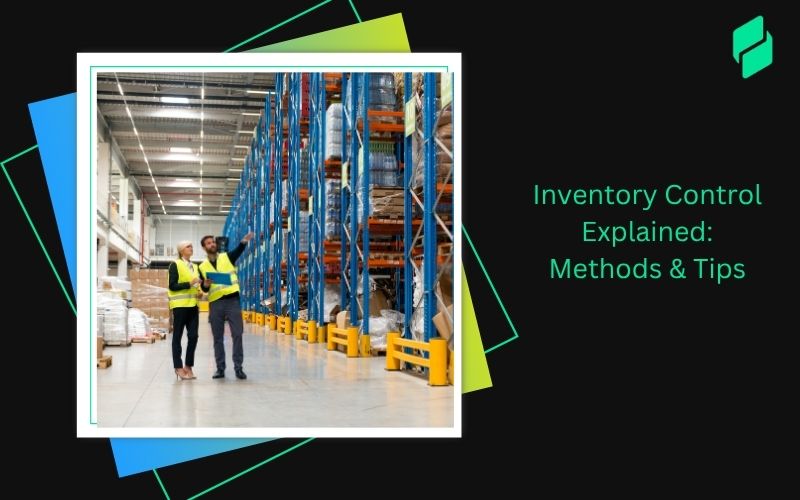Optimize your business: use unlimited savings with Pazago fulfilled now!
Get Started ->Ever had to refund a customer because their order was out of stock, even though your system said it was available? It can be frustrating and costly for those involved in international trade to encounter inventory discrepancies that disrupt their operations and affect customer trust.
In 2024, 34 percent of e-commerce businesses reported inventory discrepancies across channels, which directly led to fulfillment delays and unhappy customers. That’s not just a glitch. That’s inventory chaos.
Inventory control is the process of managing stock levels and movements to ensure the right products are available at the right time. You might hear the term “inventory control” often in logistics discussions and think it simply means counting stock.
At the surface level, it sounds simple: track your stock and keep it moving. But the reality is layered. If you’re running an e-commerce business, managing a warehouse, or handling last-mile delivery, you already know how messy inventory can get.
From raw material intake to final mile drop-offs, inventory moves through multiple checkpoints. Managing this movement efficiently is where inventory control comes in.
Let’s break down the real meaning of inventory control, why it matters, and what it can do for your business when done right.
TL;DR
- Inventory control is about staying ahead of problems, not just reacting to them. It ensures smooth operations through planning and predictive management.
- The right control method depends on your business model. What works for a small warehouse may fail in a fast-moving, multi-channel setup.
- Segmenting inventory by value or demand pattern helps prioritize attention, reduce holding costs, and improve order fulfillment.
- Tracking key metrics, such as turnover and stockout rate, provides clarity into what’s working and where stock inefficiencies lie.
- Digital tools now make real-time visibility and automated control essential, not optional, for scaling logistics and e-commerce operations.
- Effective inventory control is directly tied to customer satisfaction. Fast, accurate fulfillment builds trust and loyalty.
What is Inventory Control?
Inventory control is the process of efficiently managing and monitoring stocked goods by balancing availability, cost, and operational efficiency through tracking inventory levels, ordering, storing, and using stock to ensure the right quantity of items is available at the right time without overstocking or understocking.
Why is Inventory Control Important For Your Business?
Inventory control is vital for smooth operations and cost reduction; without it, businesses face waste, inefficiency, and lost revenue. The following points explain its importance:
- Minimizes Excess Inventory and Stockouts: Effective inventory control helps maintain optimal stock levels at all times, minimizing excess inventory that ties up capital and storage space, and preventing stockouts that result in missed sales and dissatisfied customers.
- Improves Operational Efficiency: When you know exactly what is in stock, your teams can work more efficiently and accurately. It simplifies restocking and avoids delays caused by missing items.
- Protects Profit Margins: Preventing spoilage, overbuying, and obsolescence helps reduce write-offs and improve profitability. Having key items available also ensures that you never lose revenue due to poor stock planning.
- Supports Forecasting and Planning: Inventory data highlights demand patterns and seasonal trends, providing valuable insights for informed decision-making.
- Strengthens Customer Trust: Accurate inventory control ensures timely and error-free order fulfillment. When customers receive their orders without delay, it builds reliability and fosters brand loyalty.
- Reduces Risk and Shrinkage: Well-managed inventory systems lower the risk of theft, loss, and misplacement. This leads to better accountability and stronger internal controls.
- Drives Cost Savings: Inventory control reduces storage, labor, and carrying costs. These savings can significantly impact your bottom line.
- Supports Business Growth: As a business scales, inventory management becomes more complex. A reliable system ensures that growth does not come at the cost of chaos or stock issues.
Also Read: Inventory and Warehouse Management: Differences and Best Practices
Types of Inventory Control

Inventory control systems vary based on approaches such as manual counting, automated tracking with technologies like RFID, centralized storage management, or decentralized distribution across multiple locations. The types include:
1. Manual Inventory Control: This type involves physically counting inventory and updating records by hand or using spreadsheets. It requires regular stocktaking and human oversight.
Best for: Small businesses with limited inventory and low sales volume.
2. Automated Inventory Control: This system utilizes software, barcodes, RFID, or IoT devices to track inventory in real-time. It reduces errors, improves accuracy, and enables better forecasting.
Best for: Medium to large businesses, or any business scaling operations.
3. Centralized Inventory Control: All inventory is stored and managed from a single location. This offers better control but may increase delivery time and costs.
Best for: Companies that operate from a central warehouse or have limited distribution points.
4. Decentralized Inventory Control: Inventory is spread across multiple locations or branches. This enables faster local deliveries but can make oversight and coordination more complex.
Best for: Businesses with multiple retail outlets or regional warehouses.
Before we dive into the techniques for calculating inventory control, it’s essential to understand why they matter. These methods help optimize stock levels, minimize holding costs, and prevent stockouts, making your supply chain more efficient and cost-effective. Now, let’s break down the key techniques used in logistics.
Suggested Read: How to Implement Inventory Tracking: Steps and Methods
9 Methods of Inventory Control
To understand the meaning of inventory control, it helps to know the techniques used to manage stock efficiently. Whether in warehousing or inventory control in logistics, these methods help reduce costs, avoid stockouts, and maintain smooth operations.
- ABC Analysis: Inventory is classified into A (high-value, low-quantity), B (moderate), and C (low-value, high-quantity). This helps prioritize stock management based on impact.
- Just-in-Time (JIT): Stock is ordered only when needed. This method lowers storage costs but requires accurate forecasting and reliable suppliers. It plays a key role in effective inventory control.
- Economic Order Quantity (EOQ): This formula calculates the ideal order quantity to minimize both holding and ordering costs. It supports the core concept of inventory control.
- FIFO and LIFO: FIFO sells older stock first, which is useful for perishables. LIFO sells the newest items first. Both methods affect inventory flow and cost calculations.
- Perpetual Inventory System: This system tracks stock in real time using software or scanning tools. It suits businesses that require precise and accurate inventory control in logistics.
- Periodic Inventory System: Physical counts are done at set intervals. While simple to manage, this method may cause delays in detecting stock issues.
- Reorder Point: A minimum stock level is set for each item. When inventory falls below this point, a new order is placed to prevent stockouts.
- Batch Tracking: Goods are tracked by production batches. This method is standard in the food and pharmaceutical industries, where traceability is crucial.
- Vendor-Managed Inventory (VMI): In this approach, suppliers monitor and replenish stock for the buyer. It reduces manual work and improves product availability, demonstrating that inventory control encompasses more than just internal tracking.
So, what are the metrics that you can use to measure the effectiveness of your inventory management in business? Let us understand them in detail below with examples.
You Might Also Like: Understanding the Importance and Definition of Supply Chain Visibility
9 Inventory Control Metrics to Track
Understanding the meaning of inventory control goes beyond keeping shelves stocked. It involves using data to make informed decisions that reduce costs, avoid delays, and consistently meet customer demand. Below are key metrics that help you measure the effectiveness of your inventory management, along with practical examples.
- Inventory Turnover Ratio
The Inventory Turnover Ratio measures how often inventory is sold and replaced within a given timeframe, indicating the speed of stock movement and the health of cash flow; a higher turnover rate means faster-moving stock, whereas a lower one signals overstocking or weak demand.
Formula: Inventory Turnover = COGS / Average Inventory
Example:
If your cost of goods sold is $100,000 and average inventory is $20,000:
Turnover = 100,000 / 20,000 = 5 times per year
- Economic Order Quantity (EOQ)
Economic Order Quantity (EOQ) calculates the optimal order size by balancing ordering and holding costs to minimize total inventory expenses and maintain efficient stock levels.
Formula: EOQ = √(2DS / H)
Example:
A retail store sells 10,000 phone cases per year (D = 10,000).
It costs $200 to place an order (S = $200), and the annual holding cost per unit is $20 (H = $20).
EOQ = √(2 × 10,000 × 200 / 20)
EOQ = √(4,000,000 / 20) = √200,000 ≈ 447 units per order
This means the store should order around 447 phone cases each time to reduce total inventory costs.
- Reorder Point (ROP)
Reorder Point (ROP) indicates the inventory level at which a new order should be placed to prevent stockouts, based on lead time and average usage.
Formula: ROP = Lead Time × Average Daily Usage
Example:
A grocery store sells 30 cartons of milk daily.
It takes 4 days for new stock to arrive.
ROP = 4 × 30 = 120 cartons
The store should reorder when inventory drops to 120 cartons.
- Stockout Rate
The Stockout Rate measures the frequency at which inventory fails to meet customer demand by tracking the percentage of orders that cannot be fulfilled due to a lack of stock, impacting revenue and customer satisfaction.
Formula: Stockout Rate = (Number of Stockouts / Total Orders) × 100
Example:
20 stockouts from 500 orders
Stockout Rate = (20 / 500) × 100 = 4%
- Carrying Cost of Inventory
Carrying Cost of Inventory accounts for expenses like warehouse space, insurance, and depreciation associated with storing unsold goods, highlighting potential inefficiencies or slow-moving stock.
Formula: Carrying Cost = (Holding Costs / Inventory Value) × 100
Example:
Holding costs = $1,500, Inventory value = $6,000
Carrying Cost = 25%
- Order Accuracy Rate
This measures the percentage of customer orders fulfilled correctly in terms of product, quantity, and packaging. A higher accuracy rate leads to fewer returns and a better customer experience.
Formula: Order Accuracy = (Accurate Orders / Total Orders) × 100
Example:
980 accurate orders out of 1,000
Accuracy Rate = 98%
- Safety Stock
Safety stock refers to the additional inventory held to buffer against fluctuations in demand and supply delays, thereby ensuring that operations continue smoothly during periods of uncertainty.
Formula: Safety Stock = (Max Daily Usage × Max Lead Time) – (Avg Daily Usage × Avg Lead Time)
Example:
Let’s say a company uses 50 units per day on average, but during peak demand, it can go up to 70 units.
Average lead time is 3 days, but it can take up to 5 days.
Safety Stock = (70 × 5) – (50 × 3)
Safety Stock = 350 – 150 = 200 units
Keeping 200 units as safety stock protects against uncertainty.
- Days Sales of Inventory (DSI)
DSI shows the average number of days it takes to sell through inventory. A lower DSI indicates quicker turnover and more effective capital utilisation.
Formula: DSI = (Average Inventory / COGS) × 365
Example:
Average Inventory = $1,00,000, COGS = $5,00,000
DSI = (1,00,000 / 5,00,000) × 365 ≈ 73 days
- Rate of Return
This metric tracks the percentage of products that customers return. High return rates may signal issues with product quality or fulfillment accuracy.
Formula: Rate of Return = (Returned Units / Sold Units) × 100
Example:
100 returns from 2,000 sales
Return Rate = 5%
Tracking these metrics regularly helps turn the meaning of inventory control into measurable, actionable performance. You gain better control over costs, reduce errors, and make smarter restocking decisions.
Also Read: What Is In-Transit Inventory? A Complete Guide
Best Practices of Inventory Control
The meaning of inventory control lies in managing stock so that the right products are available at the right time, without excess or shortage. Effective control reduces costs, enhances order fulfillment, and ensures operations run smoothly.
Here are the best practices to follow:
1. Categorize Inventory Using ABC Analysis: Not all products carry the same value. Classify inventory based on importance:
- A-items: High-value, low-quantity items (need tight control)
- B-items: Moderate value and volume (routine monitoring)
- C-items: Low-value, high-quantity items (bulk management)
This method helps prioritize attention and resources.
2. Set Par Levels and Reorder Points: Establish minimum stock levels (par levels) for each product. Use reorder points based on sales velocity and lead time to trigger restocking before you run out of stock. This reduces the risk of stockouts and delays.
3. Use the FIFO Method (First In, First Out): Ensure that older stock is sold or used before newer stock. This is especially important for perishable or seasonal items, as it helps reduce waste and obsolescence.
4. Conduct Regular Audits: Even with automation, physical checks are essential. Use a mix of:
- Annual physical inventory (full stock check)
- Cycle counting (spot-checking small sections regularly)
- Random checks (surprise audits to detect discrepancies)
5. Automate with Inventory Management Software: Use tools that offer real-time visibility into stock levels, sales trends, and reorder alerts. Look for integrations with your POS, ERP, or ecommerce platforms for end-to-end visibility.
6. Monitor Supplier Performance: Efficient inventory control depends on reliable suppliers. Track on-time delivery rates, quality issues, and responsiveness. Having backup suppliers is also a smart risk mitigation strategy.
7. Implement Just-in-Time (JIT) Inventory: Reduce holding costs by ordering stock only when needed. This requires close coordination with suppliers and accurate demand forecasting.
8. Forecast Demand Accurately: Use historical sales data, seasonal trends, and market analysis to predict future demand. The more accurate your forecasting, the more precise your inventory control.
9. Train Staff on Inventory Procedures: Human error is one of the biggest causes of inventory issues. Ensure warehouse and sales staff understand the systems in place, follow standard procedures, and report discrepancies immediately.
10. Continuously Improve: Track key performance indicators like inventory turnover ratio, holding costs, and order accuracy. Regularly review processes and adjust based on data insights.
You Might Also Like: How Logistics Operations and Supply Chain Work
How Pazago Simplifies Inventory Management Across the Supply Chain

You can’t grow a business if you don’t know what’s in stock, what’s running low, or what’s stuck in a warehouse. Poor inventory control leads to delays, stockouts, overstocking, and frustrated customers.
Pazago addresses inventory challenges by consolidating disparate data sources into clear, actionable insights, enabling better decision-making and inventory management.
- Real-Time Inventory Visibility: Like tracking shipments, knowing stock location and quantity is crucial. Pazago provides real-time visibility across warehouses and transit points. Its dashboard lets teams track movements, check levels, and fix imbalances quickly.
- Accurate and Centralized Documentation: Inventory issues often stem from poor records. Pazago centralizes all inventory data, from receipts to transfers, reducing manual errors and making audits easier.
- Risk Management Through Stock Controls: Inventory faces risks like spoilage or theft. Pazago lets businesses track expiry dates, batch numbers, and slow-moving items to reduce losses and meet compliance needs.
- Smooth Communication Between Teams: Inventory control needs coordination between procurement, warehousing, and fulfillment. Pazago keeps all teams aligned with built-in tools that allow quick updates on stock levels and restocking needs.
- Pre-Shipment Quality Checks: Verifying inventory before it's moved is key. Pazago supports digital inspection logs to flag defects, document checks, and ensure only quality stock is released.
- Simplified Transactions and Compliance: Inventory control also involves smooth procurement and sales. Pazago integrates with accounting tools to handle stock valuation, purchase orders, and compliance paperwork with less friction.
Pazago simplifies inventory control by integrating real-time visibility, automation, and analytics into a single platform, helping you save time, reduce costs, and scale your operations efficiently without chaos.
Conclusion
Inventory control in logistics involves not only tracking but also maintaining accuracy, careful planning, and ensuring operational efficiency. When done right, it helps reduce costs, avoid stockouts, and improve customer satisfaction. Whether you're managing a single warehouse or a distributed network, strong inventory control provides the visibility and flexibility to stay ahead.
Pazago makes this easier. With features like centralized inventory tracking, automated updates, and real-time visibility, Pazago helps logistics teams operate with greater speed and precision, without the manual hassle.
If you're looking to bring more control and clarity to your logistics, book a demo with Pazago today.
FAQs
1. What is the definition of inventory control?
Ans. Inventory control is the process of managing stock levels, tracking inventory movement, and ensuring that records accurately reflect the physical inventory. It helps avoid overstocking or stockouts while improving accuracy and efficiency.
2. What is inventory control in logistics?
Ans. In logistics, inventory control means maintaining the right amount of stock at warehouses and transit points to meet demand. It ensures timely deliveries, reduces excess, and supports smooth operations.
3. What is the concept of inventory control?
Ans. The concept centers on balancing product availability with cost. It aims to meet demand without tying up capital in unused stock, utilizing tools such as reorder points and stock audits to ensure accuracy.
4. How does inventory control differ from inventory management?
Ans. Inventory control handles day-to-day stock accuracy and movement. Inventory management is a broader function that includes planning, forecasting, and supplier coordination.
5. Why does inventory control matter in e-commerce?
Ans. Accurate inventory control ensures fast and correct deliveries, which is critical in e-commerce. Mistakes such as stockouts or incorrect shipments can lead to refunds, returns, and a loss of customer trust.


.png)








